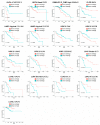Machine Learning Identifies Robust Matrisome Markers and Regulatory Mechanisms in Cancer
- PMID: 33266472
- PMCID: PMC7700160
- DOI: 10.3390/ijms21228837
Machine Learning Identifies Robust Matrisome Markers and Regulatory Mechanisms in Cancer
Abstract
The expression and regulation of matrisome genes-the ensemble of extracellular matrix, ECM, ECM-associated proteins and regulators as well as cytokines, chemokines and growth factors-is of paramount importance for many biological processes and signals within the tumor microenvironment. The availability of large and diverse multi-omics data enables mapping and understanding of the regulatory circuitry governing the tumor matrisome to an unprecedented level, though such a volume of information requires robust approaches to data analysis and integration. In this study, we show that combining Pan-Cancer expression data from The Cancer Genome Atlas (TCGA) with genomics, epigenomics and microenvironmental features from TCGA and other sources enables the identification of "landmark" matrisome genes and machine learning-based reconstruction of their regulatory networks in 74 clinical and molecular subtypes of human cancers and approx. 6700 patients. These results, enriched for prognostic genes and cross-validated markers at the protein level, unravel the role of genetic and epigenetic programs in governing the tumor matrisome and allow the prioritization of tumor-specific matrisome genes (and their regulators) for the development of novel therapeutic approaches.
Keywords: big data; bioinformatics; cancer; extracellular matrix; matrisome; regulatory networks.
Conflict of interest statement
The authors declare no conflict of interest.
Figures




Similar articles
-
Matrisomics: Beyond the extracellular matrix for unveiling tumor microenvironment.Biochim Biophys Acta Rev Cancer. 2024 Nov;1879(6):189178. doi: 10.1016/j.bbcan.2024.189178. Epub 2024 Sep 4. Biochim Biophys Acta Rev Cancer. 2024. PMID: 39241895 Review.
-
Tissue, age, sex, and disease patterns of matrisome expression in GTEx transcriptome data.Sci Rep. 2021 Nov 3;11(1):21549. doi: 10.1038/s41598-021-00943-x. Sci Rep. 2021. PMID: 34732773 Free PMC article.
-
The extracellular matrix: Tools and insights for the "omics" era.Matrix Biol. 2016 Jan;49:10-24. doi: 10.1016/j.matbio.2015.06.003. Epub 2015 Jul 8. Matrix Biol. 2016. PMID: 26163349 Free PMC article. Review.
-
Epigenetic Mechanisms Histone Deacetylase-Dependent Regulate the Glioblastoma Angiogenic Matrisome and Disrupt Endothelial Cell Behavior In Vitro.Mol Cell Proteomics. 2024 Mar;23(3):100722. doi: 10.1016/j.mcpro.2024.100722. Epub 2024 Jan 23. Mol Cell Proteomics. 2024. PMID: 38272115 Free PMC article.
-
The cancer matrisome: From comprehensive characterization to biomarker discovery.Semin Cell Dev Biol. 2019 May;89:157-166. doi: 10.1016/j.semcdb.2018.06.005. Epub 2018 Jul 13. Semin Cell Dev Biol. 2019. PMID: 29964200 Review.
Cited by
-
The Burden of Post-Translational Modification (PTM)-Disrupting Mutations in the Tumor Matrisome.Cancers (Basel). 2021 Mar 3;13(5):1081. doi: 10.3390/cancers13051081. Cancers (Basel). 2021. PMID: 33802493 Free PMC article.
-
A functional outside-in signaling network of proteoglycans and matrix molecules regulating autophagy.Matrix Biol. 2021 Jun;100-101:118-149. doi: 10.1016/j.matbio.2021.04.001. Epub 2021 Apr 7. Matrix Biol. 2021. PMID: 33838253 Free PMC article.
-
Tumor collagens predict genetic features and patient outcomes.NPJ Genom Med. 2023 Jul 6;8(1):15. doi: 10.1038/s41525-023-00358-9. NPJ Genom Med. 2023. PMID: 37414817 Free PMC article.
-
Machine learning-based approach for automated classification of cell and extracellular matrix using nanomechanical properties.Mater Today Bio. 2024 Jan 20;25:100970. doi: 10.1016/j.mtbio.2024.100970. eCollection 2024 Apr. Mater Today Bio. 2024. PMID: 38312803 Free PMC article.
-
A pan-cancer analysis of matrisome proteins reveals CTHRC1 and a related network as major ECM regulators across cancers.PLoS One. 2022 Oct 3;17(10):e0270063. doi: 10.1371/journal.pone.0270063. eCollection 2022. PLoS One. 2022. PMID: 36190948 Free PMC article.
References
-
- Rianna C., Kumar P., Radmacher M. The Role of the Microenvironment in the Biophysics of Cancer. Semin. Cell Dev. Biol. 2018;73:107–114. - PubMed
MeSH terms
Substances
Grants and funding
LinkOut - more resources
Full Text Sources
Medical

